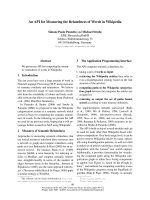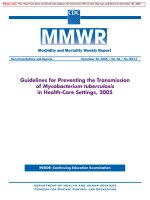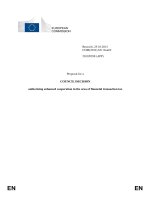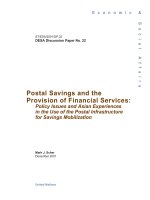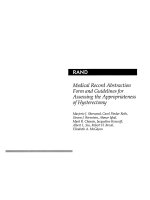Broader Policy Conclusions for Enabling the Promotion of Financial Inclusion while Achieving Financial Integrity
Bạn đang xem bản rút gọn của tài liệu. Xem và tải ngay bản đầy đủ của tài liệu tại đây (336.24 KB, 8 trang )
C h ap t e r 6
Broader Policy Conclusions for
Enabling the Promotion of Financial
Inclusion while Achieving Financial
Integrity
Preview
This chapter provides:
• A discussion of key policy objectives for achieving financial integrity and
financial inclusion for the remittance sector.
• Key policy recommendations for regulators and other authorities.
Key Policy Objectives for Achieving Financial Integrity and Financial
Inclusion for the Remittance Sector
Financial integrity and financial inclusion are mutually reinforcing and interdependent public policy objectives. When they are complimentary, they reinforce
their respective objectives and contribute positively toward economic development. To this end, financial integrity and financial inclusion will benefit from
greater coordination within governments and across sectors.
A well-designed anti-money laundering/combating the financing of terrorism
(AML/CFT) regulatory regime creates an environment that fosters greater financial inclusion; similarly, improved financial inclusion leads to a stronger AML/CFT
regulatory regime (see figure 6.1). Ill-designed and overly rigid AML/CFT regulatory frameworks,1 however, unnecessarily increase costs and create other disincentives for remittance service providers (RSPs), other financial institutions, and
consumers, and curtail financial inclusion efforts. Financial exclusion cultivates
conditions that enable informal financial service providers to thrive and informal
Making Remittances Work • />
109
110
Broader Policy Conclusions for Enabling the Promotion of Financial Inclusion while Achieving Financial Integrity
Figure 6.1 Complimentary Effect of Strong AML/CFT Regime and Improved
Financial Inclusion
Stronger AML/CFT regime
Improved ability to trace and monitor transactions
and less use of cash transactions
Smaller informal sector and expanded formal sector
Less demand for informal financial services
Improved financial inclusion
Smaller informal sector and expanded
formal sector
Reduced remittance costs and created incentives for
informal players to register due to balanced regulation
Well-designed AML/CFT regime based on
risk-based approach.
Note: AML/CFT = anti-money laundering/combating the financing of terrorism.
financial channels to be more competitive.2 Informal financial channels cannot
easily be traced, recorded, or monitored, thus increasing the likelihood of suspicious and illicit transactions through these channels. Hence, they undermine the
very objective of AML/CFT efforts. Financial inclusion is therefore a multidimensional challenge, of which AML/CFT requirements are an important aspect.
While it is not the only cause of financial exclusion, regulatory challenges in
some countries may have created barriers to the capacity of financial institutions
to conduct business and innovation, thus undermining their ability to promote
greater financial access. For example, many citizens in poor countries do not have
legitimate identification (ID) documents that fulfill AML/CFT requirements
established by domestic authorities due to an underdeveloped and inadequate ID
infrastructure. This makes it difficult for money transfer businesses (MTBs) and
any other financial institutions to provide financial services to customers without
the required ID documents.
The fact that policy makers, regulators, MTB supervisors, and MTBs themselves do not have a clear understanding of the flexibility of Financial Action Task
Force (FATF) standards on AML/CFT has led many countries to overregulate
certain financial services and products that may not pose high money laundering/
financing of terrorism (ML/FT) risk. At the same time, many countries have not
introduced a risk-based approach (RBA) to AML/CFT requirements, which has
added unnecessary regulatory compliance costs and created other disincentives
for MTBs and other financial institutions. This study argues that to the extent
that countries bring the industry under AML/CFT regulatory and oversight
Making Remittances Work • />
Broader Policy Conclusions for Enabling the Promotion of Financial Inclusion while Achieving Financial Integrity
mechanisms with enforcement, understand ML/FT risks posed to the sector, and
the industry conducts ML/FT risk assessment and complies with regulatory
requirements, MTBs should pose no greater risk than any other financial
institution.
In addition, policy makers in some countries are still unsure of how to address
the AML/CFT implications for new financial service providers such as mobile
network operators and their agents (such as retail businesses and retail outlets in
the provision of financial services). Often, regulators are not yet familiar with
these new entities or products. Hence, many countries are taking cautious
approaches in regulating these new service providers, resulting in preventing such
businesses from entering the markets, or entering markets with limited functionalities (such as a prohibition on international remittances). These entities could
and should be leveraged to assist in achieving financial inclusion targets, and in
doing so, a risk-based approach to AML/CFT regulations should be considered.
It is therefore imperative to address these regulatory challenges in order to
create a regulatory regime that is effective in risk mitigation while also conducive
to financial inclusion goals.
The FATF has tried to explain the flexibility of the standards by issuing a guidance paper on AML/CFT and financial inclusion in June 2011 and a revised guidance paper on AML/CFT and financial inclusion in February 2013 to reflect the
2012 changes in FATF Recommendations.3 This seems to be having a positive
impact, since regulators around the world feel more comfortable introducing
simplified due diligence for lower-ML/FT-risk scenarios.
Based on the discussions and findings in this study, the key policy recommendations are presented to national regulators and supervisors of remittance markets, with the objective of achieving a balance between financial integrity and
financial inclusion. These policy recommendations are presented under three
themes: (a) money laundering and terrorist financing risks and related challenges,
(b) regulatory and supervisory frameworks, and (c) market entry.
Key Policy Recommendations
1.Money Laundering and Financing of Terrorism Risks Associated with the
Remittance Sector
• Conduct a detailed risk assessment of the remittance sector, which will assist in
risk-based supervision and facilitate applying the AML/CFT measures in a
manner proportionate to the identified risks. In this regard, it is important
to explore and analyze the identified ML/FT cases and classify them in
order to identify typologies that involve the use of RSPs. These assessments
will identify the different ML/FT risks faced by the RSPs, their channels,
and their products and services. If regulators are contemplating who should
be allowed to operate remittance services, the risk assessment would help
determine the types of remittance business models that are best suited to
local remittance market structure, and its cross-border features. Moreover,
such assessment would help remove the misconception that all MTBs are
Making Remittances Work •
111
112
Broader Policy Conclusions for Enabling the Promotion of Financial Inclusion while Achieving Financial Integrity
uniformly riskier. As such, the authorities can focus on the specific risks that
may exist within their MTBs, beyond a one-size-fits-all approach. This will
in-turn help alleviate debanking of MTBs by the banking sector, as seen in
certain countries, which occurred due largely to the fear of heavy enforcement actions on the banks. Risk assessment should help both the supervisors and the supervised (in this case, banks) to understand that different
MTBs pose different ML/FT risks. It would also provide necessary guidance
in designing an RBA to AML/CFT regulation and supervision.
2.Regulatory and Supervisory Framework and Implementation of AML/CFT
Preventive Measures
• Adopt a risk-based regulatory framework. Once a sound ML/FT risk assessment has been conducted, developing a risk-based regulatory and supervisory framework is a critical step. The objectives and approach of laws and
regulations governing remittance services may differ among countries based
on development level, economic environment, and other factors.
Nevertheless, there should be risk-based regulation that reduces barriers to
formally serving customers, while still ensuring that customers are adequately protected. Large volumes of informal remittances still exist in many
countries, which is partly associated with the existence of undocumented
migrant workers and of populations with no ID documents. Thus, regulations
need to accommodate, on a risk-sensitive basis, those segments of the population whose source of money for remittances may be legal but who are not
able to use formal channels due to regulatory requirements relating to strict
interpretation of customer due diligence (CDD).
• Ensure an RBA with respect to CDD obligations. The FATF Recommendations
allow for simplified CDD measures where there is a lower risk of ML/FT. It
is advisable to introduce “proportionate” risk-based regulation for CDD to
enable customers to access formal channels and present information that is
necessary to mitigate ML/FT risks according to its transaction size. In this
regard, introducing a “tiered-approach” to CDD would be advisable, under
which CDD obligations progressively tighten as the ML/FT risk increases.
Simplified due diligence can also be used for opening low-value/lower-risk
accounts into which remittances can be transferred and easily accessed.
Simplified due diligence may also consider differentiating between the ID
and verification process, to determine an area where flexibility could be better accorded. The scope and level of the simplified CDD can be decided in
regulations or at the financial institution level. If decided at the financial
institution level, authorities should assess the validity of the RBA undertaken by the financial institutions.
It is also recommended to balance regulatory concerns about agents
with the financial inclusion objective. Agents of RSPs should be allowed to
perform ID and verification obligations, which would enhance financial
inclusion by expanding the geographic outreach.
Making Remittances Work • />
Broader Policy Conclusions for Enabling the Promotion of Financial Inclusion while Achieving Financial Integrity
• Ensure an effective supervisory framework. To achieve effective supervision,
consider adopting an RBA to the supervision of the remittance market, especially in countries where the number of licensed or registered remittance
service providers is large. The institutions to be visited, and the scope and
periods of the on-site visits, should be designed based on the findings of prior
risk assessment. An RBA also forces examiners to focus on actual risks as
opposed to perceived risks.
On-site supervision should be complemented by adequate off-site
monitoring mechanisms. This is important since risk-based design of on-site
visits will largely depend on findings and on the analysis of off-site supervision or monitoring. Supervisors should have adequate resources and skills
to perform their duties.
In many countries, MTBs heavily depend on agent networks in providing
services. It is unlikely that the supervisors can make on-site visits to all
agency locations, but rather conduct sample testing. In this regard, it is essential to assess the internal control systems of principal MTBs to ensure that
their agents follow adequate internal AML/CFT policy and procedures.
It is critical that appropriate sanctioning powers are available to
supervisors. Sanctions, particularly in relation to breaches of AML/CFT,
should be clear, and supervisors should not hesitate to exercise their
power and impose sanctions when necessary.
• Encourage active communication with market players. Undertake more institutionalized and regular communication with remittance market players.
Designing laws and regulations without consulting the private sector could
bring unintended negative consequences if regulators did not understand
the market well. Therefore, it is advisable to ensure that there is regular and
proactive consultation and outreach with institutions subject to AML/CFT
regulations, before laws and regulations are introduced or amended, to
ensure that the proposed laws and regulations are practical, and also to
secure buy-in from the private sector. The private sector is often in a position
to offer constructive solutions to regulatory challenges from a practitioner’s
point of view. Such a consultation process among all relevant stakeholders
leads to proactive adaptation of relevant laws and regulations and achieves
effective implementation of the laws and regulations in the market.
Providing proactive guidance to regulated institutions is important in assisting them to implement AML/CFT laws and regulations.
3. Market Entry by MTBs
• Encourage innovation and competition by allowing a wide range of service
providers. Consider permitting a wider range of entities to conduct remittance activities either as a principal and/or as an agent of an RSP. Be flexible enough to experiment with various types of new technology remittance
models such as “e-money,” mobile money, and other remittance business
models. Explore permitting the use of retail “agents” for mobile money
Making Remittances Work •
113
114
Broader Policy Conclusions for Enabling the Promotion of Financial Inclusion while Achieving Financial Integrity
cash-in and cash-out functions. This might facilitate the distribution of
remittances, especially in remote or hard-to-reach areas. It could also accelerate the access of unbanked customers to basic financial services in a manner that otherwise might not be possible, and would facilitate electronic
tracking and monitoring of greater numbers of financial transactions in the
event law enforcement authorities need to do so to fight crimes. It may be
useful for authorities to issue guidelines for e-money and other innovative
remittance products, such as prepaid cards and Internet-based remittance
services. As long as the risks are appropriately mitigated, regulators and
regulations should not be a hindrance to the development of the private
sector and private sector innovation.
• Consider the best fit between the two choices of licensing or registration regimes
as the appropriate method of market entry. In doing so, authorities should take
into account ML/FT risk mitigation requirements, incentives for formalization, cost at entry and over time, and regulatory or supervisory capacity. Such
choice might not be an either/or approach, since tiered market entry regimes
might provide a sound balancing act in terms of risk mitigation and effective
allocation of resources. Such a decision process is also relevant for agents,
notably in light of the flexibility allowed by the FATF standards, between a
system where agents are subject to registration or licensing, or one where the
principals are responsible and accountable for maintaining the list of agents.
In many countries, putting the responsibility on principals is likely to be a
promising approach, provided the obligations of principals are duly enforced.
When an informal market is relatively large, instituting a registration
regime rather than a licensing regime may be more appropriate for principal RSPs, as would listing of agents by the principal for agents of the RSPs.
• Bring the informal players into the formal system. Today, a still significant portion of remittance flows passes through informal systems. To encourage
informal market players to become formal participants, authorities should
conduct a comprehensive assessment of the remittance market to identify
the informal service players, design a regulatory framework including market entry requirements whose bar is not too high for informal players,
develop awareness programs to explain the formalization process, allow
reasonable time for licensing or registration with competent authorities, and
continue to engage with them for a reasonable period of time. Sanctions
should be used only as a last resort in this process.
Notes
1.For a detailed discussion on key regulatory impediments to financial inclusion, see
appendix J.
2.As the formal remittance market becomes more competitive, there is less cost advantage for informal channels; however, in many countries, informal channels are still
Making Remittances Work • />
Broader Policy Conclusions for Enabling the Promotion of Financial Inclusion while Achieving Financial Integrity
extremely cost-efficient and fast in processing cash transactions, with little or no
process for verifying the ID of money senders or recipients. Usually these informal
systems are outside the regulatory parameters, and the nontransparent nature of these
systems is a weak link in AML/CFT regimes focused on financial transactions. This
informal alternative means that such funds transfer providers are often not licensed
or registered with authorities, and that the funds transfers and related transactions are
usually not recorded, cannot be traced, and therefore pose higher integrity risks.
3.See FATF 2011, />/fatfguidanceonanti-moneylaunderingandterroristfinancingmeasuresandfinancialincl
usion.html. This paper has been revised and updated to reflect the changes in
the FATF recommendations adopted in 2012. The revised guidance paper, published
in February 2013, is available at /> ocuments/
reports/AML_CFT_Measures_and_Financial_Inclusion_2013.pdf. The lead author of
this report, Emiko Todoroki, provided substantial inputs to these guidance papers as
a co-project leader of these projects.
References
FATF (Financial Action Task Force). 2011. FATF Guidance: Anti-Money Laundering and
Terrorist Financing Measures and Financial Inclusion. Financial Action Task Force,
Paris, June. />measures%20and%20financial%20inclusion.pdf.
———. 2012. International Standards on Combating Money Laundering and the Financing
of Terrorism and Proliferation: The FATF Recommendations. Financial Action Task Force,
Paris, February. />/pdfs/FATF_Recommendations.pdf.
———. 2013. FATF Guidance: Anti-Money Laundering and Terrorist Financing Measures
and Financial Inclusion. Financial Action Task Force, Paris, February. f
-gafi.org/media/fatf/documents/reports/AML_CFT_Measures_and_Financial
_Inclusion_2013.pdf.
Making Remittances Work •
115

